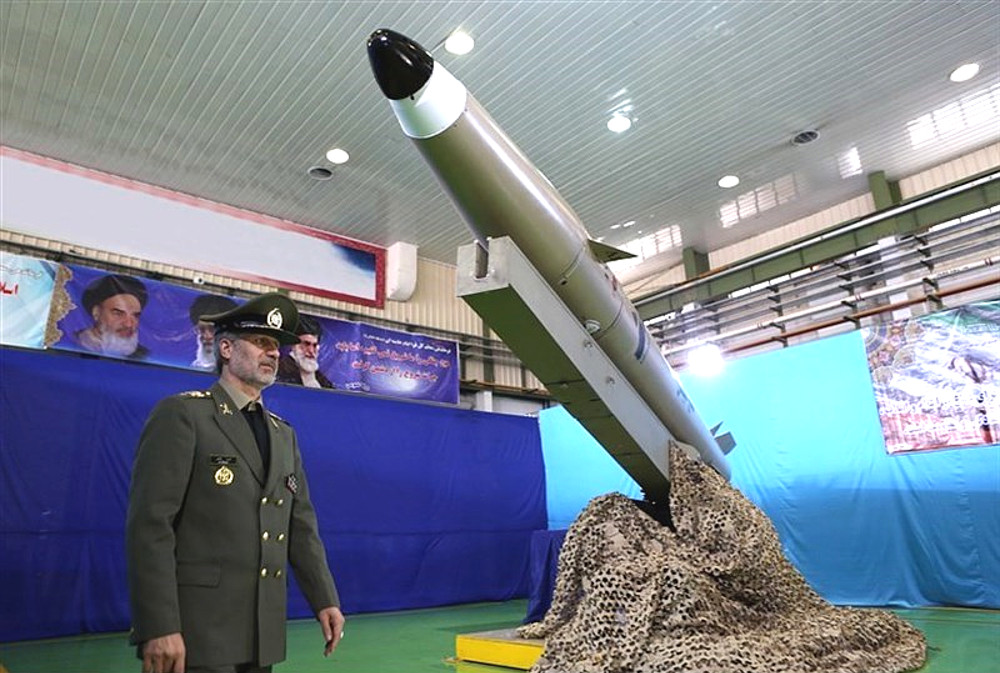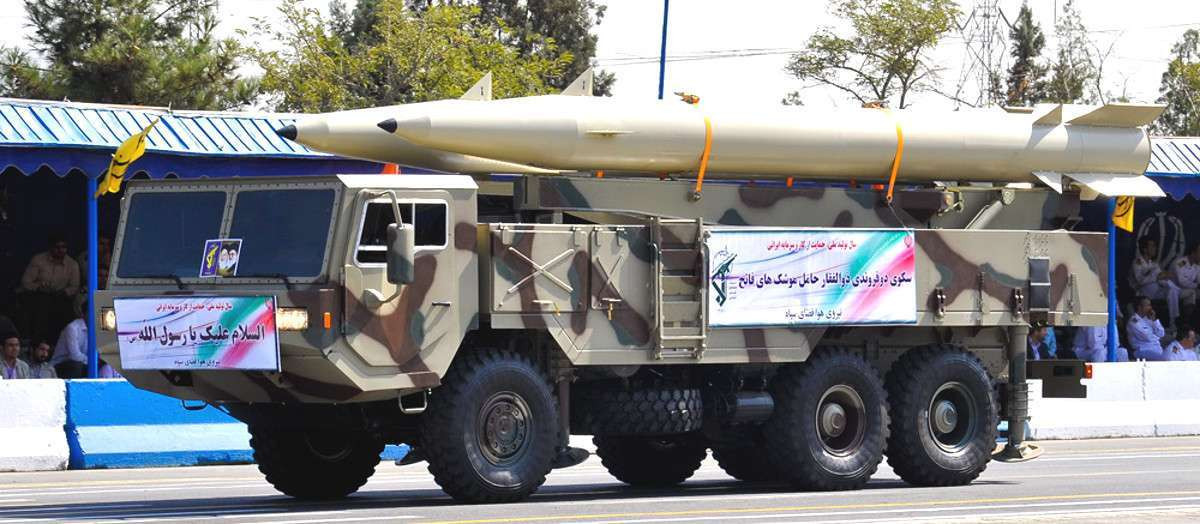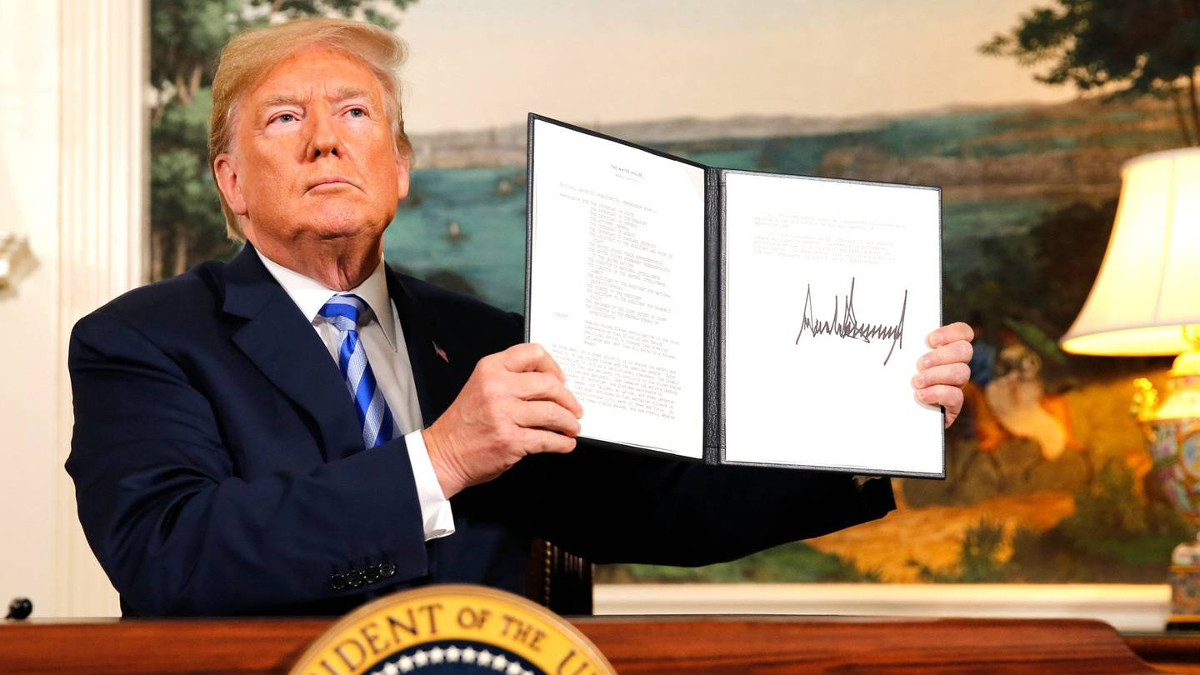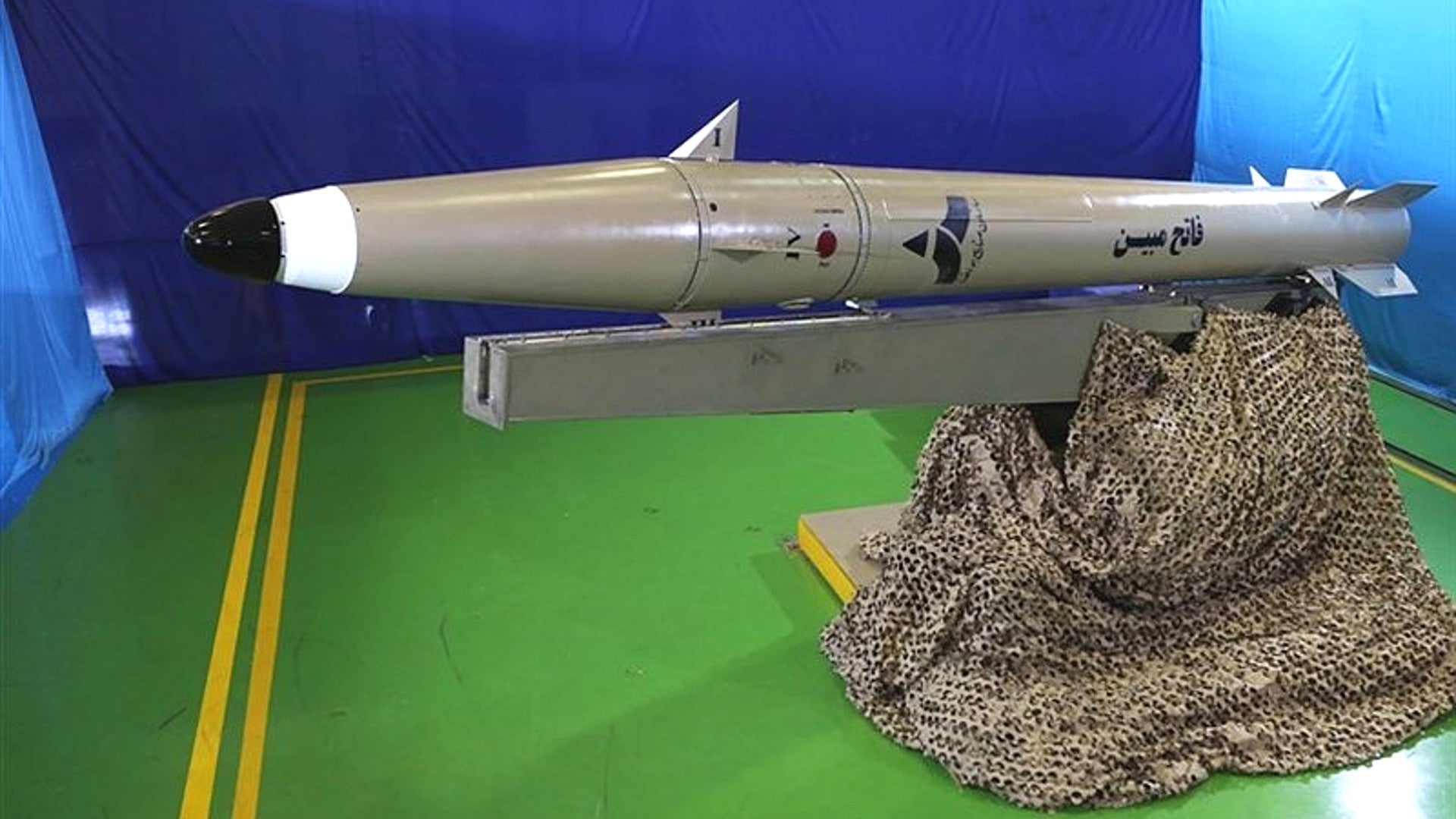Iran has unveiled a new type of Fateh 110 short-range ballistic missile, the Fateh Mobin, which it claims is more precise than previous variants and has improved “stealth” features to defeat enemy ballistic missile defenses and other countermeasures. The announcement follows reports that the Iranian Islamic Revolutionary Guard Corps, or IRGC, had fired an unknown version of this weapon during a recent exercise in and around the Strait of Hormuz, but it is unclear if the launch during the drills was a test of this upgraded design.
Iranian Minister of Defense Amir Hatami revealed the Fateh Mobin in a ceremony on Aug. 13, 2018 in Tehran. The country’s top military officer also took the opportunity to send a defiant message to the country’s unnamed “enemies,” almost certainly a reference to the United States and Israel, saying the weapon was an example of the country’s deterrent and military industrial capabilities and that the it would never abandon its ballistic missile development programs.
“The Islamic Republic of Iran’s missile power is a defensive deterrent power and as I had promised our dear people,” Hatami said, according to Iran’s semi-official FARS News Agency. “I will not spare any efforts to increase the country’s missile capabilities and certainly, we will increase our missile power on a daily basis.”
Hatami did not offer any detailed specifics about the Fateh Mobin missile itself and it is unclear how it differs from late model Fateh 110s. The only clear visual difference is a rounded nose cone instead of the older, pointed design, which Iran’s top military officer said contained an upgraded guidance system.

“Nothing can stop this missile because of its high degree of flexibility,” Hatami declared. The Fateh Mobin is “100-percent domestically made… agile, stealth, tactical [and] precision-guided.”
There are reports that this newly-debuted missile may have a satellite navigation system-assisted inertial navigation system guidance package, as well as an imaging infrared sensor, the latter of which would give it a capability to hit moving targets, including ships. Video purportedly showing an undated Fateh Mobin test that emerged online to go along with the announcement appears to show the missile using the latter system to zero in on a mock building.

However, there have been reports that these guidance options have been available for the Fateh family of missiles since at least June 2017. It is possible that the Fateh Mobin features improved versions of those guidance systems and is more precise.
There is nothing about the weapon’s shape, or its other external characteristics, that supports Hatami’s other claims. The basic shape of the body and arrangement of the control surfaces is visually identical to older Fateh 110 types. There is no indication that the Mobin model has any stealthy features that could hide it from enemy radars or that it is any more maneuverable than previous types, which might allow it to better dodge enemy ballistic missile defenses.
It is possible that the Iranians have reduced the infrared signature of the missile at launch or have improved its guidance system to allow the weapon fly a more unusual trajectory to its target, both of which could make it more difficult for an opponent to spot or track before trying to shoot it down. At the same time, Iran has a long history of making dubious claims about its military capabilities. Dynamically guided ballistic missiles are a tough thing to perfect in general.
That’s not to say that the Fateh Mobin, or its various cousins, aren’t worrisome, especially in regions where it might already be difficult to maneuver, such as the Strait of Hormuz. In June 2017, the IRGC launched a number of Zulfiqar missiles, a derivative of the Fateh 110 with slightly increased range and a warhead full of small submunitions ideal for attacking area targets, ISIS terrorists in Syria retaliation for attacks the group had staged in Tehran earlier that month.

With their moving target and anti-ship capabilities, a barrage of Fateh 110s or more recent derivatives with unitary warheads could also help Iran deny, or at least slow, more conventional opponents from accessing certain areas. These weapons already present a standing threat to both warships and commercial shipping transiting back and forth between the Persian Gulf and the Gulf of Oman.
It is also unclear whether or not the IRGC fired one of these Mobin variants during exercises aimed at demonstrating that force’s ability to blockade the strategic Strait of Hormuz earlier in August 2018. On Aug. 10, 2018, Fox News reported that these drills included the launch of a third generation Fateh 110 in an anti-ship configuration, though the weapon reportedly struck a mock target on land.
reports about the Fateh Mobin did not mention that exercise at all. In addition, this latest ballistic missile news came from Iran’s Ministry of Defense, which is separate and distinct from the powerful paramilitary IRGC. The video reportedly showing a test launch of the new type is undated and could be from the recent exercises, other tests in March 2017, or an entirely unrelated event.
Whether or not the Fateh Mobin announcement is linked in any way to the drills in the Strait of Hormuz, it is clearly a response to the U.S. government’s decision to reimpose various sanctions against Iran earlier in August 2018. This was the result of U.S. President Donald Trump’s decision to withdraw the United States from the controversial multi-national agreement regarding Iran’s nuclear program.

“What is said about the Islamic Republic’s defense and missile power is a cheap and baseless claim and clear meddling, and the great Iranian nation does not allow any foreign power to interfere in its defense and military affairs,” Hatami said during his speech. “The more intense are sanctions, pressures, smear campaigns, and psychological warfare against the great nation of Iran, the greater will become our will to enhance our defensive power in all areas.”
In pulling out of the Iran deal, Trump specifically cited continued Iranian ballistic missile developments as an example of the agreement’s inherent flaws. The president and other critics had long complained that the arrangement did not include specific provisions aimed at restricting the regime in Tehran from furthering this work and continuing to pursue other malign activities that threaten the interests of the United States and its allies in the Middle East and beyond.
Though a valid criticism, the question remains about whether abandoning an existing agreement and starting from scratch to try to address those issues has been, or will turn out to be, a fruitful course of action. On Aug. 13, 2018, separate from the Fateh Mobin ceremony, Iran’s Supreme Leader Ayatollah Ali Khamenei took to Twitter to explain why his regime is disinclined to negotiate with the United States in general and declare that it would never agree to talks with the Trump Administration in particular.
At the same time, Iran’s economy has already suffered a slump recently, which has, in turn, led to protests aimed at President Hassan Rouhani and the country’s religious leadership. The potential impact of U.S. sanction may already be feeding into this, for better or worse, and it’s unclear what effect this might have on Iran’s capacity to develop new and improved ballistic missiles and other weapons.
But, curiously, the U.S. government’s response to news surrounding developments with the Fateh missile continues to be muted, in stark contrast to even recent statements from Trump and other officials. In July 2018, the president Tweeted out a fiery message aimed at Rouhani, threatening “consequences the likes of which few throughout history have ever suffered before” if Iran continued to challenge the United States.
Trump has, so far, not issued any statement specifically about the IRGC firing the Fateh 110 during the exercises in and near the Strait of Hormuz, Iran’s first launch of any kind of ballistic missile in over year, or in response to this “new” missile. Other U.S. government agencies have not criticized these developments, either. On Aug. 12, 2018, during a press gaggle with reporters while en route to Brasilia, Brazil for an official visit, Secretary of Defense James Mattis did not mention Iran once.
On Aug. 10, 2018, an apparent Arabic-language U.S. Department of State-linked Twitter account, which oddly has the handle @DOTArabic, claimed that that IRGC head Major General Mohammad Ali Jafari had announced another new missile development. The State Department’s English-language social media accounts did not repeat this announcement and there was no readily apparent reporting of Jafari’s statements in English-language Iranian media.
A crude machine translation of the text suggested that whoever had written the message had made confusing and incorrect claims, including that Iran had a cruise missile capable of hitting targets at distances greater than 930 miles and that this was in violation of United Nations Security Council Resolution 2231. That resolution only forbids Iran from development ballistic missiles and only those that could carry nuclear warheads.
A cruise missile of any kind, such as the air-launched type Iran showed off in April 2018, would not be subject to these restrictions and Iran argues that all of its missiles are exempt since it claims it is not working on any nuclear weapons. If Jafari had actually been talking about a ballistic missile, the question would then be why this statement is notable now given that he had publicly declared that Iran had examples of these weapons with maximum ranges of at least approximately 1,240 miles and was continuing to develop them in October 2017.
Since the U.S. Intelligence Community has likely been aware of these developments in part or in full for some time, there remains the possibility that American officials themselves do not put the Fateh series of missiles in the same category as Iran’s more strategic weapons. It is also possible that the U.S. government is in the process of crafting additional sanctions packages or formulating a new diplomatic push to further isolate Iran and is, therefore, waiting to reveal a larger critical assessment of Iranian ballistic missile work in the future.
Not ratching up the rhetoric and looking to see how domestic discontent with the regime evolves, especially as the latest sanctions come into force, would be a sensible approach for the U.S. government to pursue in general. Doing so helps deny the Iranian regime an easy way to refocus domestic anger and criticism from its own policies onto an external actor. It would also be uncharacteristic of the Trump Administration.
What we do know from the Fateh Mobin revelation is that Iran is determined to demonstrate that it is designing and producing increasingly capable ballistic missiles, and will continue to do so, regardless of existing and future sanctions. But just how “new” this latest version of the Fateh missile is in actuality remains to be seen.
Contact the author: jtrevithickpr@gmail.com
